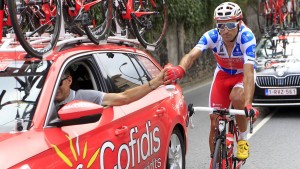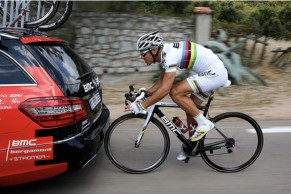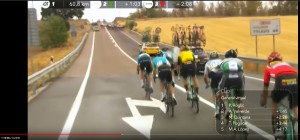How long cyclists can be pushed when handed a sticky bottle?
While the UCI is still determined to regulate what in many cases are small things, it continues to turn a blind eye in the stages with what is known in the jargon as sticky bottle, that is, the impulse that the cyclist receives from his team car when picking up a jerrycan.

When the bottle sticks to the rider's hand
This is a common image in any race. A rider drops out of the peloton to the line of cars where his team's car is waiting to supply him with water bottles. After filling his jersey with 8, 9 or even more jars full of liquid, the last one is held by his director who, in turn, accelerates the car to give the cyclist a boost that allows him to return to the peloton with the least expenditure of strength.
So far so good, a totally common situation that the commissaires usually turn a blind eye to. The problem comes when these images are reproduced among riders who are in the breakaway or when one of them is dropped, not because he intentionally goes down to look for liquid but because of circumstances of the race and that saving bottle allows him to return to the group.
RECOMENDADO

The best apps for cycling and mountain biking

Black Friday 2025 cycling bargains: save on Garmin, POC, Maxxis and more

Black Friday Garmin 2025: the ultimate guide to choosing your GPS at the best price

Do you need suspension on your gravel bike?

A real workout saver of only 56 min on the turbo trainer

Which profile wheels to choose according to the area where you live: mountain, flat or coast

It is here when the controversy arises because it depends on the subjective vision of the referee judges when the aid is of excessive duration or occurs at unjustified times, which can lead to a penalty in time or economic or even the expulsion of the rider from the race as, for example, happened to Elisa Balsamo during the dispute of the Paris-Roubaix 2022.
Something similar happens with protecting oneself from the wind behind the team cars. Here the rule is somewhat clearer, since when the cyclist is in the line of cars following the peloton, it is permissible to ride behind the vehicles, jumping from car to car until reaching the group. This is common when riders suffer a flat tyre, a crash or simply stop to relieve themselves. However, it is very different when this cut is produced by race circumstances. Here again, the judge-referee's subjectivity comes in to apply a penalty for what the rules define as "prolonged shelter".

The "barrage" rule stands out in this respect. When there is a cut in the peloton, the judges have to determine when the team cars may or may not overtake the group. This is something that often causes tension between directors and referees when situations arise. Normally, the rule is that cars cannot pass until there is a one-minute gap between groups, although it is up to the stewards to decide when they allow the cars to pass and, conversely, when they stop the cars accompanying the escapees.
As we commented a few days ago about the application of the protocol for extreme weather conditions, it is ironic that cycling is so precise in its rules for things like setting the height of socks or the minimum width of a handlebar, but leaves so many things to the subjective criteria of the judges that, as with all arbitrary aspects, end up not pleasing anyone.